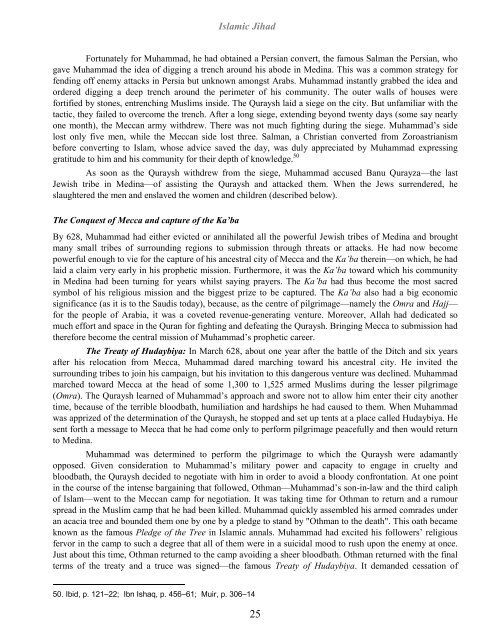islamic-jihad-legacy-of-forced-conversion-imperialism-slavery
islamic-jihad-legacy-of-forced-conversion-imperialism-slavery
islamic-jihad-legacy-of-forced-conversion-imperialism-slavery
- No tags were found...
You also want an ePaper? Increase the reach of your titles
YUMPU automatically turns print PDFs into web optimized ePapers that Google loves.
Islamic JihadFortunately for Muhammad, he had obtained a Persian convert, the famous Salman the Persian, whogave Muhammad the idea <strong>of</strong> digging a trench around his abode in Medina. This was a common strategy forfending <strong>of</strong>f enemy attacks in Persia but unknown amongst Arabs. Muhammad instantly grabbed the idea andordered digging a deep trench around the perimeter <strong>of</strong> his community. The outer walls <strong>of</strong> houses werefortified by stones, entrenching Muslims inside. The Quraysh laid a siege on the city. But unfamiliar with thetactic, they failed to overcome the trench. After a long siege, extending beyond twenty days (some say nearlyone month), the Meccan army withdrew. There was not much fighting during the siege. Muhammad’s sidelost only five men, while the Meccan side lost three. Salman, a Christian converted from Zoroastrianismbefore converting to Islam, whose advice saved the day, was duly appreciated by Muhammad expressinggratitude to him and his community for their depth <strong>of</strong> knowledge. 50As soon as the Quraysh withdrew from the siege, Muhammad accused Banu Qurayza—the lastJewish tribe in Medina—<strong>of</strong> assisting the Quraysh and attacked them. When the Jews surrendered, heslaughtered the men and enslaved the women and children (described below).The Conquest <strong>of</strong> Mecca and capture <strong>of</strong> the Ka’baBy 628, Muhammad had either evicted or annihilated all the powerful Jewish tribes <strong>of</strong> Medina and broughtmany small tribes <strong>of</strong> surrounding regions to submission through threats or attacks. He had now becomepowerful enough to vie for the capture <strong>of</strong> his ancestral city <strong>of</strong> Mecca and the Ka’ba therein—on which, he hadlaid a claim very early in his prophetic mission. Furthermore, it was the Ka’ba toward which his communityin Medina had been turning for years whilst saying prayers. The Ka’ba had thus become the most sacredsymbol <strong>of</strong> his religious mission and the biggest prize to be captured. The Ka’ba also had a big economicsignificance (as it is to the Saudis today), because, as the centre <strong>of</strong> pilgrimage—namely the Omra and Hajj—for the people <strong>of</strong> Arabia, it was a coveted revenue-generating venture. Moreover, Allah had dedicated somuch effort and space in the Quran for fighting and defeating the Quraysh. Bringing Mecca to submission hadtherefore become the central mission <strong>of</strong> Muhammad’s prophetic career.The Treaty <strong>of</strong> Hudaybiya: In March 628, about one year after the battle <strong>of</strong> the Ditch and six yearsafter his relocation from Mecca, Muhammad dared marching toward his ancestral city. He invited thesurrounding tribes to join his campaign, but his invitation to this dangerous venture was declined. Muhammadmarched toward Mecca at the head <strong>of</strong> some 1,300 to 1,525 armed Muslims during the lesser pilgrimage(Omra). The Quraysh learned <strong>of</strong> Muhammad’s approach and swore not to allow him enter their city anothertime, because <strong>of</strong> the terrible bloodbath, humiliation and hardships he had caused to them. When Muhammadwas apprized <strong>of</strong> the determination <strong>of</strong> the Quraysh, he stopped and set up tents at a place called Hudaybiya. Hesent forth a message to Mecca that he had come only to perform pilgrimage peacefully and then would returnto Medina.Muhammad was determined to perform the pilgrimage to which the Quraysh were adamantlyopposed. Given consideration to Muhammad’s military power and capacity to engage in cruelty andbloodbath, the Quraysh decided to negotiate with him in order to avoid a bloody confrontation. At one pointin the course <strong>of</strong> the intense bargaining that followed, Othman—Muhammad’s son-in-law and the third caliph<strong>of</strong> Islam—went to the Meccan camp for negotiation. It was taking time for Othman to return and a rumourspread in the Muslim camp that he had been killed. Muhammad quickly assembled his armed comrades underan acacia tree and bounded them one by one by a pledge to stand by "Othman to the death". This oath becameknown as the famous Pledge <strong>of</strong> the Tree in Islamic annals. Muhammad had excited his followers’ religiousfervor in the camp to such a degree that all <strong>of</strong> them were in a suicidal mood to rush upon the enemy at once.Just about this time, Othman returned to the camp avoiding a sheer bloodbath. Othman returned with the finalterms <strong>of</strong> the treaty and a truce was signed—the famous Treaty <strong>of</strong> Hudaybiya. It demanded cessation <strong>of</strong>50. Ibid, p. 121–22; Ibn Ishaq, p. 456–61; Muir, p. 306–1425


